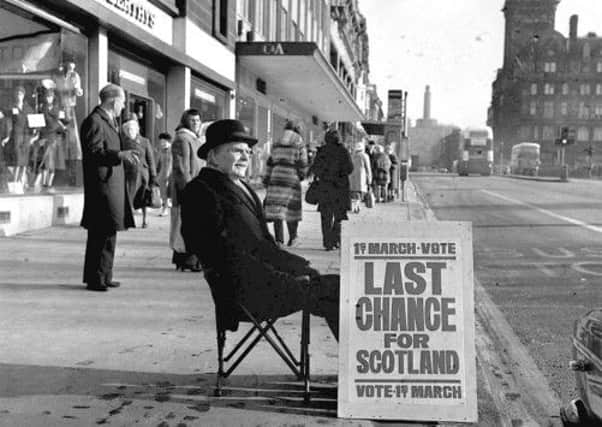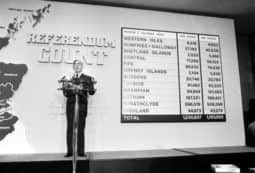Comment: impact of the 1979 devolution referendum


The champion of parliamentary sovereignty, Prof A V Dicey, distrusted referenda on principle, but he was prepared to allow one (on Irish home rule) if Westminster attempted to abrogate its own power. He died in 1923; 50 years later a British government would experiment with it.
Why? There was nothing definitive about referenda, as people believed in 1975. Entry to the EEC was endorsed, but could be put to the vote again. Scots and Welsh devolution was felled in 1979, revived in 1997. Indeed the Diceyite “status quo 1707” vanished. What “Better Together” fan would now opt for it? But the 1979 poll was an unloved hybrid, imposed by a divided Labour Party on the Scotland Bill in 1977, further flawed by the “40 per cent hurdle” clause of 1978. The Swiss, experts in the business, would have junked it like a fake Rolex.
Advertisement
Hide AdAdvertisement
Hide AdHome Rule – ditched in 1958 – returned to Labour’s programme in 1974. Hugh Gaitskell and Harold Wilson had been government economists, whose confidence sustained Labour’s elite. Life was simple when Whitehall man was always right. A Left version of this Jacobinism came partly from ex-Communist entrants after 1956: the idea of a “great lever” in London which could be pulled to install socialism.


In 1973, Crowther-Kilbrandon reported from the long grass, just when the oil-fuelled SNP took Govan. Labour faced internal pressures through ex-ILP decentralisation, revived by the rise of CND, trade-union anti-imperialism from the Communists and a “revisionism” – involving John P Mackintosh and Donald Dewar – which could co-exist with such Liberals as David Steel and Ming Campbell. The party havered, and was dragged into devolution by Harold Wilson.
Scottish Labour, reconstructed in the 1940s, distrusted John MacCormick’s two million Covenanters of 1950 (who were a plebiscite of sorts). Soft on Ulster, they alienated Labour’s growing Catholic element. But the Left swelled when the Clyde became a Polaris base and mobilised union figures like Alex Kitson and Lawrence Daly.
The post-1968 grouposcules – IMG, WRP, SWP, etc – disliked parliaments on principle. Women were ignored. None figured among the 29 writers in Gordon Brown’s 1975 Red Paper on Scotland.
The unions wanted to hammer Edward Heath, and his 1968 pro-devolution line didn’t help his party: in October 1974 the Tory vote fell to half its 1955 level. But Europe united Tories, Liberals and the Labour Right against the SNP and the Left, and Referendum One in May 1975 saw their challenge off. An omen?
Polls in 1978 showed devolution getting 60 per cent against 20 per cent for the status quo. So why neck-and-neck on 1 March, 1979? The winter of discontent? Labour divisions worsening after it checked the SNP? Devolution weakened by the psychodrama of Jim Sillars’ Scottish Labour Party, 1974-6, and unrest over deals with the Liberals?
After a decade at the Open University I could see Europe eyeing us up: from the foreign minister of Finland to the Parisian Ecole Nationale d’Administration, preparing France for Mitterand’s decentralisation. But the SNP had curbed its oil campaign, while Labour’s “party ethos” seemingly rejected the devolution implant.
Tam Dalyell bridged this as Olympian unionist and Wheatley regionalist (our local government “revolution” only dated from 1974). He schmoozed Labour’s foot-soldiers: “Betty, you’re quite right! Willy Brandt said exactly the same thing to me last weekend!” John Mackintosh could and did flatten him but he was ill, and on 30 July, 1978 he died. Gordon Brown worked hard, but was too diffuse. The grandees let him down.
Advertisement
Hide AdAdvertisement
Hide AdThe 1 March turnout was 63.8 per cent, higher than the 60.4 per cent of 11 September, 1997. Of the Regions Strathclyde, Fife, Central, Highland, Western Isles voted “Yes”; Borders, Dumfries, Grampian, Orkney and Shetland “No”. Borderlines? “No” in Tayside, “Yes” in Lothian. Overall 33 per cent to 31 per cent, well short of the 40 per cent hurdle.
Studies in Bochel, Denver and McCartney’s Referendum Experience (1983) and a later one of Central Region by Peter Lynch showed Labour activists at best blasé about devolution when faced with the coming election.When Scotsman columnist Peter Jones and I wrote The Road to Home Rule in 1999, Peter argued Margaret Thatcher would have felled an underpowered first-past-the-post Assembly. I would now dissent. Assembly elections in late 1979 would have been held against sharp inflation, factory closures, huge unemployment; looming steel and coal disputes had “national” resistance potential matching Upper Clyde in 1971.
Power-play in a FPTP Assembly could have brought a 1987-style Tory collapse. The two-member-per-seat system would have grown gender equality. The SNP, saved from a wipeout, could have harried Labour and recovered. After all, the oil at $40 a barrel was there for the Assembly to play for.
Faced with a Scottish fait accompli, Mrs Thatcher would have had to activate Lord Home’s “better way” – conceding some sort of convention. Instead we got London and corporate control, financial aggrandisement, “new media” and the bonfire of Reithian values. In 1979, the desktop computer, Walkman, internet were to come. Autonomy could have made that media revolution Scottish.
An Assembly under a Keynesian Gordon Brown? Among his 1979 supporters initiatives were maturing; the Norwegians were putting oil to work. We could have strengthened oil-politics and European connections, expanded co-op banking, experimented in marine transport and power. Me? Gone. I throve on the geld Mrs Thatcher schlepped to Baden-Wuerttemberg.
Assembly-amputation, then marketisation, hit our consciousness, and we were left, as Gwyn Alf Williams put it of Wales, “naked under an acid rain”. The social entropy pervading Andrew O’Hagan’s The Missing was a sharper 1995 expression of Thatcheritis than Trainspotting or Braveheart; by shutting off “the oxygen of publicity” London contributed the distraction of Smith-Blair-Brown, and a sense of losing time. Jim Sillars reviving the SNP in the 1988 Govan by-election gave an edge to the oncoming Convention, but he and Alex Salmond at Westminster were outmanoeuvred in 1992 by Rupert Murdoch. Tom Nairn was in Australia, but came back. Neal Ascherson would contest the 1999 Holyrood election as a Lib Dem: yet the undercurrent was elegiac.
Mrs Thatcher’s obsequies edited out oil, yet the logic of a “petropound Scots” was to tether it by investing in England. Her nursery monetarism in 1980 took sterling up to a deadly 5DM, killing 20 per cent of industry. For Sir Alastair Morton, last head of British National oil Corporation, our would-be Statoil, “She blew it on the dole.”
Of the referendum cast-list, few recovered. Gerorge Cunningham, the Labour MP who proposed the 40 per cent rule for the referendum sank with the SDP. Feminism progressed but the gender composition of the BBC’s Scotland 2000 of 1987 improved little on the Red Paper. Dalyell loathed Thatcher more than any devolver. More talented than Foot, Kinnock or Brown, Robin Cook was the most severe casualty. His 1979 “betrayal” lost him First Minister in 1998 – much to Whitehall’s relief.
Advertisement
Hide AdAdvertisement
Hide AdSuperimpose on this the recovery of the Welsh between 1979 and 1997. Living there during vacations after 1988, Wales’s political revival was skin-of-the-teeth but palpable: the nagging of Planet and Agenda and the S4C campaign succeeded because of a competitive two-language culture.
In 1979 Scotland still had 30 per cent of GDP in manufacturing instead of today’s 12 per cent, the bounty of the oil, literate newspapers with three times today’s circulations, a visual culture which produced The Cheviot (1973) and Local Hero (1983). Teachers saw their schools as missions; finance could be trusted; a common conversation hadn’t yielded to the jabber of “social media” and “reality TV”; sport had talent and community, not silly money; there were high streets, not malls.
So much to change, and another chance from renewable energy. But for the talented generation of 1979, little time to hand. Such was the cost – as Willie McIlvanney put it – of getting feart.
• Professor Christopher Harvie’s lecture takes place at 5:30pm today at the University of Glasgow. It is free and open to the public. More details at: http://www.gla.ac.uk/events/voxpopuli/one fides